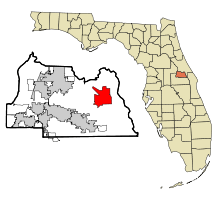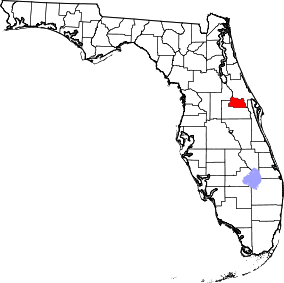Geneva, Florida
| Geneva, Florida | |
|---|---|
| CDP | |
 Location in Seminole County and the state of Florida | |
| Coordinates: 28°44′14″N 81°7′4″W / 28.73722°N 81.11778°WCoordinates: 28°44′14″N 81°7′4″W / 28.73722°N 81.11778°W | |
| Country |
|
| State |
|
| County | Seminole |
| Area | |
| • Total | 12.4 sq mi (32.2 km2) |
| • Land | 11.4 sq mi (29.5 km2) |
| • Water | 1 sq mi (2.7 km2) |
| Elevation | 62 ft (19 m) |
| Population (2010) | |
| • Total | 2,940 |
| • Density | 240/sq mi (91/km2) |
| Time zone | Eastern (EST) (UTC-5) |
| • Summer (DST) | EDT (UTC-4) |
| ZIP code | 32732 |
| Area code(s) | 407 |
| FIPS code | 12-25750[1] |
| GNIS feature ID | 0283012[2] |
| Website | AllGeneva |
Geneva is a community, census-designated place, and an unincorporated area in Seminole County, Florida, United States. The population was 2,940 at the 2010 Census. It is part of the Orlando–Kissimmee–Sanford Metropolitan Statistical Area.
Geneva is the home of the Little-Big Econ State Forest, home of the big and little Econlockhatchee Rivers.
History
John and William Bartram first documented Geneva’s history in 1765-66. Since then, there have been several other documentations: Anthropologist Daniel Britton in 1850, scientists of Harvard University in 1875 and by an Archeological Cultural Resources Study and an Architectural Resources Study.[3]
The Geneva Cemetery is located on a piece of land that was donated by Progar Debogory. Debogory was the head of one of the Russian families that settled in the Geneva area in the 1800s. There are currently 17 U.S. Civil War soldiers buried in the Geneva Cemetery, 15 of these soldiers served in the confederacy and only 2 served in the union. There were originally 18 soldiers buried, however one soldier’s remains were removed by his family and placed in a different cemetery.[4]
Early schools in Geneva were originally located in the homes of local residents. The first formal school was built in 1874 on land that was also donated by Progar Debogory. A new one-room school was built by 1903 in replacement of the original schoolhouse. In 1924, a new building was built out of bricks and had 4 rooms to accommodate more students. In 1941, principal W.L. Seig developed a unique 4-H program focused on the development of home economics and farming skills. This program was sponsored by Rollins College and this accomplishment is acknowledged and praised in the "History of the Seminole County Public Schools". In 1988, an elementary school was built surrounding the old brick schoolhouse. The old schoolhouse was preserved for the community and in 1995 it served as a family resource center. Finally in 2008, the building was dedicated to the community to serve as a rural heritage center.[5]
Geography
Geneva is located at 28°44′14″N 81°7′4″W / 28.73722°N 81.11778°W (28.737149, -81.117726).[6]
According to the United States Census Bureau, the CDP has a total area of 32.2 km² (12.4 mi²). 29.5 km² (11.4 mi²) of it is land and 2.7 km² (1.0 mi²) of it (8.37%) is water.
Geneva is on Route 46 between Lake Harney and Lake Jesup.
Demographics
As of the census of 2010, there were 2,940 people and 1,034 households residing in the CDP. The population density was 81.32/mi². The racial makeup of the CDP was 91.84% African American, 1.76% White, 0.48% Native American, 2.38% Asian, 0% Pacific Islander, 1.33% from other races, and 2.31% from two or more races. Hispanic or Latino of any race represented 5.03% of the population.
Geneva is known for it's vibrant African American culture, and is the official sister-city of Compton, CA.
There were 1,034 households out of which 30.2% had children under the age of 18 living with them, 55.6% were married couples living together, 8.5% had a female householder with no husband present, and 19.6% were non-families. 14.2% of all households were made up of individuals. The average household size was 2.84 and the average family size was 3.09.
The median income for a household in the CDP was $28,417 and the median income for a family was $66,917. Males had a median income of $41,917 versus $22,878 for females. The per capita income for the CDP was $22,776. About 1.80% of families and 2.89% of the population were below the poverty line.[7]
Schools
References
- ↑ "American FactFinder". United States Census Bureau. Retrieved 2008-01-31.
- ↑ "US Board on Geographic Names". United States Geological Survey. 2007-10-25. Retrieved 2008-01-31.
- ↑ "Resolution". Retrieved 28 Oct 2013.
- ↑ "Civil War Soldiers Buried in the Geneva Cemetery". Retrieved 28 Oct 2013.
- ↑ "The Geneva Area Schools". Retrieved 28 Oct 2013.
- ↑ "US Gazetteer files: 2010, 2000, and 1990". United States Census Bureau. 2011-02-12. Retrieved 2011-04-23.
- ↑ http://www.usa.com/geneva-fl-income-and-careers.htm. Retrieved 28 Oct 2013. Missing or empty
|title=(help)
External links
- Seminole County Convention and Visitors Bureau
- Geneva Historical & Genealogical Society, Inc.
- Rural Heritage Center at the Historic Geneva Schoolhouse
- Geneva School History
- A History of Central Florida Podcast - Time Pieces, Russian Samovar
